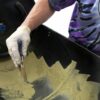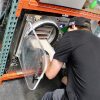We need to clear up some confusion about kief vs hash. Although they share a lot of similarities, they’re not the same thing. They have different extraction requirements, and each one comes with its own set of pros and cons. If you’re interested in producing or marketing either of these popular concentrates, it helps to understand the nuances of each one. They’re not as different as you may think—and, in fact, you can even produce them using the same equipment in some cases.
The Difference Between Kief vs Hash
The main difference between kief and hash is that kief is the unrefined mix of the flower’s resin glands that usually contains other bits and pieces of organic plant matter while hash is a refined cannabis concentrate made from kief that is pressed, separated, filtered, or otherwise concentrated into a higher-quality form. But while that’s the simplest way to distinguish kief from hash, the more nuanced definitions can get a bit messy. For instance, while kief generally refers to the loose trichomes that separate from the plant (unrefined), the term is also used, in many cases, to describe dry sift (refined). Dry sift usually refers to refined kief that is then sold as-is as a bowl topper, pressed into rosin, or blasted in a closed loop hydrocarbon system. To confuse matters even more, dry sift is technically a form of hash, but many processors reserve the term “hash” for bubble hash (aka ice water hash), distinguishing it from dry sift hash (commonly referred to as “sift”). So… The term “kief” can refer to loose kief or dry sift. The term “hash” can refer to dry sift or bubble hash. To keep things simple for the purposes of this article, we’re going to stick with the meanings commonly used in extraction circles. So, from here on out, “kief” will refer to unrefined dry sift and “hash” will refer to bubble hash.
An Overview of Kief
“Kief” (كيف kīf) is a Moroccan Arabic term meaning “joy.” You can collect kief and sprinkle it into joints or bowls, or it can be purified into the refined form of dry sift. Unrefined kief is usually greenish brown in color due to the excess plant material left behind. By filtering the kief through a series of extremely fine mesh screens (3 to 4 screens are commonly used, often between 80 and 180 microns), you can separate the excess plant material from the trichomes and achieve a purer and more desirable concentrate. This may be achieved with a simple multi-chamber herb grinder or a full-fledged industrial trichome sifter depending on the needs of the processor. Refined sift takes on a tan or even white color and can contain up to 60% THC. It can be added to joints or blunts, used as a starting material for hydrocarbon extraction, or used to make super-potent products like moon rocks. If you achieve a full-melt or close-to-full-melt dry sift, you can also consume kief in its concentrate form with a dab rig or vaporizer. Full-melt sift is very difficult to achieve, however, and usually requires a thorough static tech treatment to remove excess plant material. For more information, refer to our guide to how to make full-melt dry sift. One of the most common use cases for great-quality sift is to press it into rosin. This is an excellent way to achieve a shelf-quality, dabbable concentrate. Lower-quality sift can be pressed (while dark) into food-grade rosin, which is excellent for full-spectrum solventless edibles.
An Overview of Hash
Bubble hash uses an ice water extraction process and is generally regarded as a higher-quality alternative to dry sift. This distinction is perhaps a bit unfair (as you can have premium sift and poor-quality bubble hash), but it’s certainly easier to achieve a 5- or 6-star (the gold standard) product using the ice water extraction method. Whereas dry sift is acquired by filtering and pressing kief, bubble hash is acquired by submerging cured or frozen cannabis into an ice water bath and separating the trichomes through a process of agitation. As the cannabis flowers freeze, the agitated trichomes separate from the cannabis plant and float to the bottom of the extraction vessel, where they’re filtered through a series of mesh-lined extraction bags (bubble bags). The hash is collected, dried, and used just like refined sift. The main difference is that bubble hash tends to be more dab-friendly than sift even without static tech.
Pros and Cons of Hash vs Kief
Although the dry sifting process and the ice water extraction process are both means to the same end (separating and concentrating the cannabis resin), hash and kief each have their own unique merits. On the hash side:
- Bubble hash is typically a higher-quality product, with less residual plant material and a more melt-friendly consistency.
- Bubble hash typically fetches a higher dollar amount for extractors looking to market their product.
- Bubble hash accommodates fresh frozen cannabis. You can submerge your live cannabis flower into the ice water vessel and then transfer the hash into a freeze dryer without ever disrupting the cold chain.
On the kief side:
- Kief requires less equipment and less effort to produce. There’s also less mess involved.
- Kief generally takes less time to produce. The extraction process is quick, and the resulting concentrate doesn’t need to be dried afterward.
- The sifting process is one of the simplest ways to prep fresh marijuana plants for further extraction, allowing you to achieve a purer and more potent final extract with minimal effort.
And, of course, there are a few benefits that both cannabis concentrates share. Perhaps most notably, they’re both 100% solventless, so you can achieve a concentrated product without introducing any foreign chemicals or additives.
Bridging the Gap Between Kief and Hash
In an age of expanding recreational and medical cannabis legalization, the market is getting more saturated than ever, so it’s important for industry professionals to understand not only the differences between these cannabis products but also how to create them more efficiently and with higher quality. The primary distinctions between kief and hash—at least in terms of difficulty and product quality—are becoming smaller and smaller thanks to emerging technologies. For instance, it’s no longer necessary to invest in large, costly hash washing systems to produce bubble hash at scale, nor do you need to rely on imprecise hand-sifting methods to make quality kief. You can do it all with The Original Resinator. Just load your live or cured cannabis into the Resinator drum and load the appropriate micron-rated screen for your desired concentrate (refer to our micron chart for a complete breakdown). If you want to make premium bubble hash, just fill the drum with ice and water and turn on the machine. If you want dry sift, insert the provided coil hose to fill the chamber with liquid CO2 (which is used as a freezing agent, not a solvent) to flash-freeze your biomass and separate the kief from the cannabis buds. One great thing about making sift in the Resinator is that the liquid CO2 eliminates the need for dry ice. We never recommend using dry ice because it pops trichome heads and gives you a lower-quality concentrate. The Resinator’s liquid CO2 technology gives you the same type of freezing process without the downsides of dry ice. Whether you’re making hash or kief, you don’t need to press or manually agitate your plant material in the Resinator, as the cylinder takes care of it for you. Our state-of-the-art Cryo-Sieve® process simplifies everything. It’s an affordable way to increase your throughput and reduce your labor requirement—all while producing a much higher-quality product. If you’ve been wanting to make kief and dry sift at your operation, which can be used for a wide variety of profitable SKUs, make sure to contact our experts today so they can set you up with the best possible solution. Hash may still have the edge over kief, but when you have the best tools at your disposal (and follow a few best practices), it’s absolutely possible to create a mind-blowing product in either category—and with less effort.





